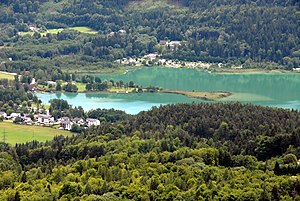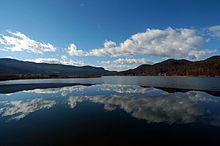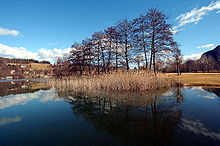Keutschacher See
| Keutschacher See | ||
|---|---|---|

|
||
| Eastern part of the Keutschacher See with peninsula | ||
| Geographical location | Carinthia , Austria | |
| Tributaries | Rakouzabach, Weissenbach | |
| Drain | Reifnitzbach (in the Wörthersee ) | |
| Places on the shore | Plescherken, Plaschischen | |
| Data | ||
| Coordinates | 46 ° 35 '10 " N , 14 ° 9' 40" E | |
|
|
||
| Altitude above sea level | 506 m above sea level A. | |
| surface | 1.327 km² | |
| length | 2 km | |
| width | 1.1 km | |
| volume | 13,600,000 m³ | |
| Maximum depth | 15.6 m | |
| Middle deep | 10.3 m | |
The Keutschacher See ( Slovenian : Hodiško Jezero ) is located in Carinthia , Austria , south of the Wörthersee . With an area of 1.32 km², it is the sixth largest of the Carinthian lakes . In 1864 Ferdinand von Hochstetter discovered a pile dwelling settlement from the Neolithic Age , which has been part of the UNESCO World Heritage Site of Prehistoric Pile Dwellings around the Alps since 2011 .
geography
The lake is located in the area of the Sattnitz in the Keutschacher Seental , which owes its origin to a branch of the Draugletscher . This has reshaped the tectonically pre-formed valley furrow. In the past, the lake was much larger than it is today, as can be seen from the extensive moorland areas to the east and north of the lake.
The lake has an elongated oval shape. In the west there is a bay, here the tributaries flow. To the east is a narrow peninsula that protrudes around 400 m into the lake. In the middle of the lake there is a shoal where the water is only 1.6 m deep. Both the peninsula and the shoal are part of rock ribs that sweep under the sea floor in a south-west-north-east direction. The lake reaches its maximum depth of 15.6 m near the shoal in the middle of the lake. In the west of the lake there are silted areas that extend with their moors to the Hafnersee . There is also a small pond here, the so-called bog pond. The moor is covered with sedges and reeds.
The catchment area of the lake covers 28.4 km². Around 54% of this is forest, 30% is agricultural land, 6% is water, the rest is settlement and recreational areas.
Hydrology and ecology
A tributary of the Keutschacher See is the Rakoza or Rodabach, which flows through the Hafnersee . The moors in the east of the lake also drain into the Keutschacher See via a small stream (Moorbach), but the parts of the Seental further east drain to the east. The Weißenbach and two nameless streams flow from the Sattnitz.
The lake warms up quickly in spring and regularly reaches water temperatures of over 25 ° C in the middle of the lake. The edge areas become even warmer. In winter it freezes over regularly and often has a closed ice cover from January to March.
The theoretical water renewal time is 0.8 years, the average discharge 0.56 m³ / s.
The lake is holomictic and has two phases of circulation in spring and autumn.
The sea water has a hardness of around 10 degrees and is therefore medium-hard. The electrical conductivity is 280 and 330 μ S / cm. The phosphorus concentration in the surface area is around 8 mg per m³, so the lake can be classified as oligotrophic , i.e. poor in nutrients.
The predominant algae are the dinoflagellates Ceratium hirundinella and Gymnodinium helveticum , as well as various diatoms of the genus Cyclotella . The animal plankton is composed of 14 kinds of rotifers and several small crustaceans together: Eudiaptomus gracilis , Mesocyclops leuckarti , Thermocyclops sp, and the water flea species. Daphnia hyalina , Daphnia cucullata , Bosmina longirostris , Diaphanosoma brachyurum , Ceriodaphnia pulchella and Leptodora kindtii . The tufted mosquito larva Chaoborus flavicans dominates the low -oxygen deep water .
Around 1975 the migrating mussel ( Dreissena polymorpha ) was introduced into the lake, its larva is part of the plankton.
The main fish species in 1992 were white bream and other carp fish , as well as pike and catfish . In 2009 the main fish were perch , roach and rudd , with perch making up around half of all individuals. The catfish is still well represented.
In the 20th century, largemouth bass , pikeperch , eel , amur carp , silver carp and white carp were used, and the lake trout also occurs occasionally .
In total there are 19 species of fish: whitefish , lake trout , pike, catfish, eel, chub , bream , bitterling , silver bream, crucian carp , carp , arbor , roach, rudd, tench , silver carp, perch, walleye and largemouth bass.
There are occurrences of the noble crayfish in the bank areas of the lake as well as in inflows and outflows .
use
The lake is privately owned and is a popular bathing water. The fishing rights are also privately owned, and fishing plays a certain role.
On the south shore, there are two FKK - camping for 3,000 guests.
Pile dwelling settlement
On the shoal in the lake there was a pile dwelling settlement around 6000 years ago that was used for around 300 years. It is one of the oldest of four pile-building periods in Central Europe. The water level of the lake was then about 1.5 m lower than it is today, which is why the shallows partly protruded from the water as an island. The stakes were made from different types of wood. Two oak trunks were dendrochronologically based on the felling year 3947 and 3871 BC. Dated. Radiometric data from other finds are dated 4340 to 3780 BC. Chr. Indicated. There were two types of houses in the settlement: log houses with mud-smeared walls and half-timbered houses made of wickerwork. The number of houses is not known. The clay dishes found in the settlement are assigned to the Lasinja-Kanzianiberg type, which belongs to the Danubian culture of the Copper Age . Hunting game dominates among the animal bones found, especially the red deer with 59%. Cattle are also represented to a notable extent with 13%. There is also evidence of copper processing, but the finds cannot be classified with any certainty in the earliest period.
natural reserve
With the exception of the north bank, most parts of the lake and its catchment area lie in the Keutschacher Seental conservation area.
See also
literature
- Hans Sampl: Lakes and ponds of the Keutschacher Seental . In: Bettina Golob, Helmut Zwander (eds.): The Sattnitz. Conglomerate of nature in the south of Carinthia . Natural Science Association for Carinthia , Klagenfurt 2006, ISBN 3-85328-041-2 , pp. 29–44.
Web links
Individual evidence
- ↑ List of UNESCO
- ↑ a b c d e f Carinthian Institute for Lake Research: Carinthian Lake Report 1992. 60 years of lake research, 30 years of lake restoration . (= Publications of the Carinthian Institute for Lake Research 7) Klagenfurt 1992, pp. 119-134.
- ↑ a b c d e f g Keutschacher See (Carinthian Institute for Lake Research) , accessed February 9, 2011.
- ↑ Paul Gleirscher: From primeval life on the water . In: Bettina Golob, Helmut Zwander (eds.): The Sattnitz. Conglomerate of nature in the south of Carinthia. Natural Science Association for Carinthia, Klagenfurt 2006, ISBN 3-85328-041-2 , pp. 53–694.
- ↑ A Neolithic Pile Dwelling in Keutschacher See? Palafitte research in Keutschacher See. ( Memento of the original from July 19, 2016 in the Internet Archive ) Info: The archive link was inserted automatically and has not yet been checked. Please check the original and archive link according to the instructions and then remove this notice. Report, VIAS Dendrolab (undated; pdf, vias-dendro.univie.ac.at) - with detailed references to the history of research.



